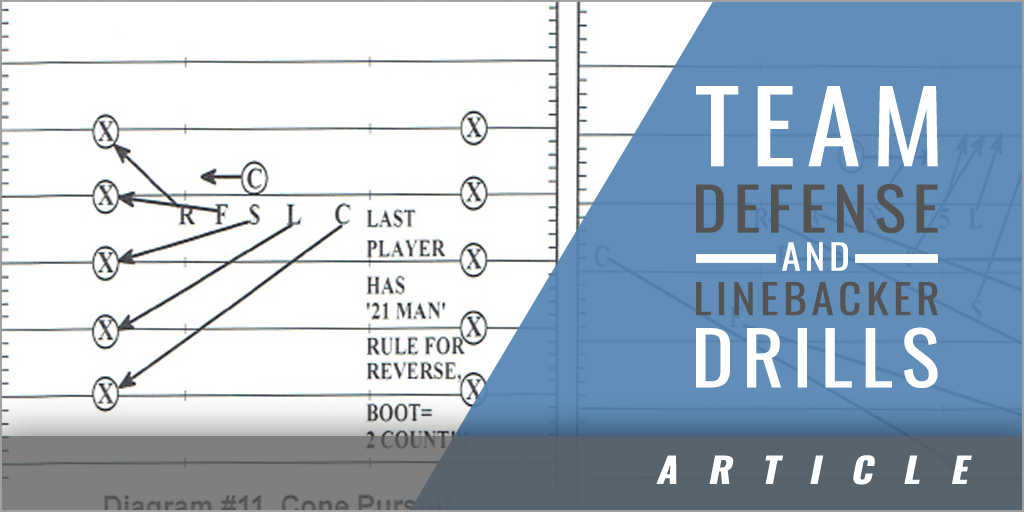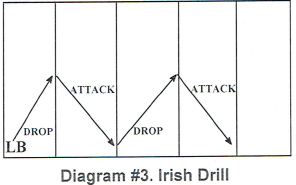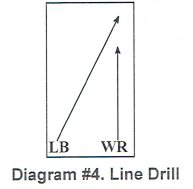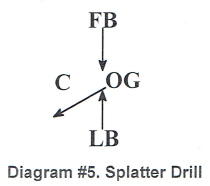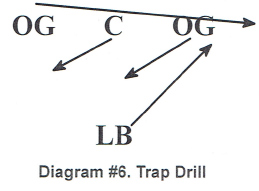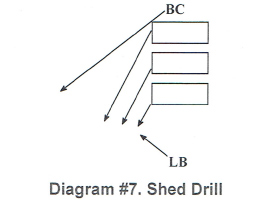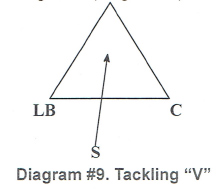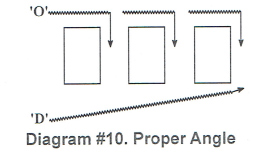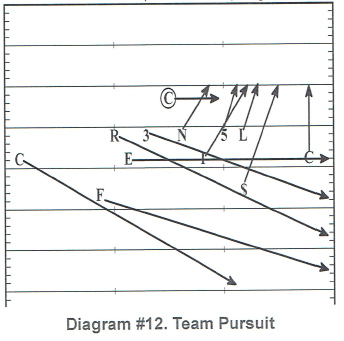| Linebacker Drills and Defensive Team Drills
By: Jeff Neal - Moller HS (OH) Originally Published - Nike 2014 Coach of the Year Clinics Clinic Notes - by Earl Browning
Today, I am going to talk about a hodgepodge of topics. I want to talk about some linebacker drills, defensive team drills, and some of the things we do in film breakdown and scouting. In our 4-4 scheme, our linebackers read the guards. We read the triangle of the two guards, quarterback, A-back, and B-back. (Diagram #1) We read from guard to guard, quarterback, and backs. In some weeks, we are heavy reads on the guards, and in other times it is the backs we read. The true backs read is like an l-formation, which is almost a dinosaur these days.
With the spread teams, we see the back in the pistol behind the quarterback or in an offset position beside the quarterback. In that case, we sometimes cross key. The linebacker reads his guard to the back on the other side of the formation. Today, we key the guard more than we key the backs. The initial indicator from the guard is whether the play is a running or a passing play. The second indicator from the guard is the direction of a running play. We do not have spring practice. In Ohio, we get 10 days before August to work with our players. You can split those days or take them all at once. What we do is start in mid-July and roll all those days together. That gets us into August and our two-a-day practices. During the off-season, I want my coaches to put together a list of 20-25 drills. We introduce those drills to the players in those 10 days before we start practice. During the 10 days, you can use them any way you please. If you want to meet three time in a day, that is fine. That is when we install and teach our schemes and drills. I want the coaches to list the drills they introduce in July and August. I want them to have a name for each drill so the players can identify the drill. Some of the drills on that list, we may not use until week eight of the season. You may only have one option team on your schedule and that game is in the eight game of the season. That is when you need that drill. As they implement the drills on their list. I want the coaches to check them off. When the games start in August, the drills must become drill specific. That is the big part of coaching. The drills fit the teams you play against. If you play an option team, you need to drill a different set of skills needed to play those teams. In our pre-season scrimmages, we scrimmage Ridgewood High School. They are a Division II team but they have won a state championship. We scrimmage them for one reason. They run the option and they have fast athletes. We will not see another option team during the regular season until we play Colerain High School in the state playoffs. I want to show you these drills. They are not revolutionary by any means. In our practice, we have 18 six-minute periods. Typically. you have one period for these individual drills. Linebacker Drills:
These simple drills do not involve a lot of teaching. I cannot stand it when a coach thinks that drill time is a lecture hall. Explain the drills in the meeting room and work on the field. Do not spend three of the six minutes of the drill explaining what they should already know. The players do not want to hear it. They are not in school they are playing football. The first drill is the Navy drill. (Diagram #2) We put the linebacker in a 5-yard box. He is in the middle and the coach is in front of him. All we do is work his hips and feet. We point to spots in the square to assimilate a linebacker movement. We give him isolation movement and he fills straight ahead. We give him off-tackle movement and he fills on an angle toward the corner of the box. We give him pass drops inside and outside. We give him lateral movements left and right. After each movement, he hustles back to the center of the box in front of the coach. It is fast concise movements.
We name these drills after where we saw them used. We went to a Navy camp and that is where the Navy drill came from. The next drill is the "Irish" drill. It came from Notre Dame.
The point of emphasis is to come under control as he gets to the sidelines. The sideline to us is the line of scrimmage. You do not want a linebacker attacking the line of scrimmage out of control. He has to collect himself and get ready to play. It is as if the player was blitzing. You do not want him flying through the line of scrimmage out of control. Players get it in their minds that every time we blitz the play is a pass. If you try to teach them the difference between a blitz and a stunt, you are wasting your time. Spend time on getting their feet back under their shoulders so they can play football when they get to the line of scrimmage. In this drill, include a ball. Somewhere in his drop movement, throw him the ball. I simply whip it to him underhanded. That doubles the drill to a foot and hip movement drill to include a ball catching drill. I do this drill in pre-game. The "line" drill is a pass coverage drill. (Diagram #4) We work between two yard lines. The linebacker works on his trail technique against a wide receiver. This assimilates a tight end or number-2 receiver going vertical down the field. We do not ask the linebacker to control or stop the receiver because there is a safety over the top in a game situation. All he does is get into a trail position and trails the receiver. The lines of linebackers start at the corner of the two yard markers and the receiver is on the next yard line.
The linebacker waiting his turn plays the offensive guard and gives the linebacker in the drill a high hat movement. That keeps the linebacker from developing bad habits. They develop enough bad habits in seven-on-seven camps. Within the 10 days of practice in July, teams go against other teams in a seven-on-seven practice. We are at the point where we do not do that anymore. You see things in the camps that you never see in the season. You may play the same team in week eight of the season and they run nothing they ran in the camp. They are drawing plays in the dirt. We call these camps "recess ball" It makes you so unsound defensively. We finally approached the game as working on what we needed to work on. We went into the game and played a single coverage regardless of what formation they used. The seven-on-seven camp comes down to a third and long scenario. We wanted to get good at what we needed to do. The "splatter" drill is a lead back drill. (Diagram #5) There is an offensive guard. center. and fullback in the drill. The linebacker aligns over the guard and reads him. When the guard blocks down, it is the easiest read in football. The linebacker fills downhill. The splatter part of the drill is the hand placement of the linebacker. He is not going to take the block of the fullback on with a shoulder and rip technique. He centers his head down the middle of the fullback under his chin and delivers a double hand shiver into the breastplate of the fullback. He uses his hands as weapons. He wants to meet the fullback at the line of scrimmage or one yard deep in the backfield
We want to make the back make a decision on which side to run. If the linebacker takes the block on with his shoulder, it is an easy read for the back. If the safety does not fit correctly, that becomes a big gain. We splatter the block and play either side. That takes all the thinking out for the linebacker. He does not need to worry whether he spills the ball to the inside or outside. He plays the splatter technique every time, in all our coverages. When you do a drill, it has to show up in the actual game. If you cannot find your drill in the game, do not do the drill. We do a similar drill called the "trap" drill. (Diagram #6) In the drill, we have a center and two guards. The linebacker reads the triangle. He sees the center block back and guard block down. The linebacker has to beat the pulling guard to the spot of the trap.
The guard is 280-pounds, the linebacker is fast and athletic, and he should beat him to the spot. He can cover the four and half yards distance before the tackle can cover the four yards to the trap spot. He wants to meet the guard on the line of scrimmage or one yard deep in the backfield. If the linebacker meets the guard on our side of the line of scrimmage it amounts to a three-yard gain. You take the one yard and add the momentum of the runner, gives them a three-yard gain. Our linebacker depth is four and half yards. Against option teams, we back up to five yards. I do not want to be tight against option teams. We use the "shed" drill, to play outside verses multiple blockers. (Diagram #7) In the drill, there are three dummy holders and one ball carrier. The linebacker attacks the first dummy holder, sheds, keeps his outside arm free, and moves to the next bag holder. He repeats the technique with the second and third bag holders. After the last bag, he makes a form tackle on the ball carrier. He uses an angle tackle technique in the tackle.
The first bag holder becomes the next linebacker and we repeat the drill. The linebacker becomes the ball carrier and everyone shuffles up to his turn at linebacker. We can run more than one group and get twice the repetitions. Linebackers love to blitz. The problem occurs when they go against a big guard or tackle and he is eaten alive because he has no technique as a pass rusher. We teach the linebackers pass rush moves. I want them to master two moves. There must be 50 moves, but we only need two. It does not matter what moves they are as long as he is good at doing them. Coach him with moves that fit him physically. Do not teach a swim move to a short defender. He cannot do it. The first thing you must teach a linebacker is to grab the outside triceps or at least cloth of the offensive blocker with his outside hand. He has to turn the shoulders of the blocker. The movement I teach is to punch with the inside hand through the outside shoulder of the offensive blocker. The linebackers have to pull their hips past the blocker and rip down with the inside arm to clear the blocker. If you do not rip through and clear. the blocker will simply grab the arm of the rusher. We do the rip the same way. We grab the triceps with the outside hand and turn the shoulders. The second movement is to dip to the inside and rip the inside hand and arm through to the outside. In these moves. it is important to attack half the blocker. We want to work on a shoulder not down the middle. The only time you work down the middle is the bull rush. That move is for linebackers on running backs. It is a matter of strength and momentum. In the pass rush drill, we work straight down the line of three dummies, working on his pass rush technique. I teach swim, rip, and bull. (Diagram #8) They can use others if they choose. Some of them want to use a spin move. If they use the spin, they must be one yard by the quarterback before they use it. If they spin and end up under the quarterback, he can escape the rush and break contain, if that happens, the linebacker is beside me on the bench.
On an inside zone play, the offensive linemen show you their numbers. They stay square to the line of scrimmage with their shoulders. The running backs will do the same thing. When the linebacker sees this, there is no fit or gap for him to fill. The play can hit anywhere. The important blocks for the offense are the backside blocks. We tell the front side linebacker there is no predetermined hole. They must check the front side guard's hip, center, and backside guard for the cutback lanes. On the outside zone, the linemen's shoulders are going to turn to the sidelines. They look like defensive linemen on a pass rush. They try to rip past the defenders outside of them. They do not care if they get upfield to linebacker depth at all. They want to keep contact and let their back beat your linemen and linebackers. The linebacker must see and recognize what scheme they are seeing. In team defense, the linebacker reads his guard as in the drill work we did. If he gets a down block, it is isolation or trap. If the guard pulls to the center, he is a backside A-Gap player. If the guard pulls to the outside, he is an off-tackle fit. The high hat is a pass set. If a team splits their offensive linemen into wider than normal splits, we do not honor them. The reason they split is to widen the defenders. He hunkers down and plays football where he is. The outside defender may honor a slight split by the tight end, but if they get ridiculous, we stay inside. If you go with the offensive linemen, you are doing something they want you to do. Midline teams like to split the guard and take the 3-technique wider. Veer teams like to do the same things. We do not, as a rule, honor those splits but we base everything we do on our game planning.
In our alignment, our Sam linebacker is one yard off the tight end. The other outside linebacker is the Rover. He aligns 4 X 4 off the offensive tackle. With the Sam linebacker, we may play a spy-technique. If the tight end is an All-American and we think the Sam linebacker will have trouble handling him, we back him off to three-yards. That makes the tight end move to block the Sam linebacker. If we are in an even numbered coverage, the Rover linebacker drops to the hash 10-12 yards off the ball. His reads are the same. He still keys the tackle. At Moeller, over the course of the season we may see a tight end three times. The Sam linebacker aligns in a 6-technique head up on the tight end and one yard off the ball. He reads the eyes of the tight end. He has to make four reads. There is a defensive end aligned outside the Sam linebacker in a 1 X 1 alignment on the tight end.
I am going to get into some tackling fundamentals. I am sure most of you do these things already. TACKLING:
When we talk about tackling drills; we talk about creating a "V." (Diagram #9)
In the diagram, the corner has outside leverage on the ball carrier. The linebacker has inside leverage and the safety is coming into the "V" to make the tackle. If it is a quarterback scrambling or a running back running, the defense wants to create the "V." We want outside leverage, inside leverage, and someone coming down the middle, that is called the finish. The first thing we do in practice is the pursuit drill, which gets them warmed up and going. This is before we get to the individual period. We have a tackling circuit that we do daily. We stress the fundamentals of tackling in that circuit. In the tackling circuit, we have three stations set up. This is a six-minute period. The players will be at each station less than two minutes. It must go fast. We have the defensive backs coach, defensive line coach, and linebackers coach doing their own type of tackling drills. The players rotate through those stations doing all types of tackling drills. TACKLING CIRCUIT
The tackling circuit are close order drills. They are not highly violent drills. We work on the fundamentals of tackling and do not get anyone hurt. We do a simple drill called "head on" tackling. The name does not indicate what we do. We have a defensive player on one side of a bag and an offensive ball carrier on the other side. On the command, the ball carrier runs to one side of the bag or the other. The defensive player mirrors the movement of the ball carrier and makes an angle tackle using the fundamentals of tackling. We never take anyone to the ground in a tackling drill. We hit wrap up and drive back, but never take them to the ground. We do a full take down drill where the tackler hits the ball carrier and drives through him to the ground. However, we do it into a high jump pit or a stack of gym mats. There are too many injuries that occur when a players is tackled to the ground. He puts his hand down and breaks a wrist or some other stupid thing happens. Use what you have available and keep your players from getting hurt. We tackle from the front into the pit and from the side into the pit. We have a drill called "proper angle" which is the old "eye-opener" drill. (Diagram #10) The ball carrier has three gaps he can turn into with the ball. The defender starts on the other side of the dummies, shuffles down the dummies, and maintains the proper angle to make the tackle.
The objective of the drill is not to overrun the ball. The linebacker wants to stay slightly behind the ball carrier so when he cuts into one of the gaps, the linebacker can angle tackle from the inside/out. He wants to put his head across the ball carrier and drive him out of the gap. He does not take him to the ground. The emphasis is proper angle to the ball and proper tackling fundamentals. We do a goal line tackling drill. The defender aligns at the two-yard line and lies on his back. The ball carrier aligns on the five-yard line. On the command, the ball carrier tries to score. The defender rolls off the ground and tries to keep him from scoring. The tackler meshes with the ball carrier and does not take him to the ground. You do not want a defensive lineman going against a defensive back. The coach can always control that. That is the quickest way to get someone hurt. If that happens the coach is at fault. Make sure you match up the participants in the drill. You can practice tackling on the seven-man sleds. We have a sled that is for that purpose. It does not move. It is set in concrete and is for tackling and blow delivery. It is spring-loaded and will compress. but you do not drive it around the field and make huge gouges in the field. After we do our dynamic stretch each day, we go to team pursuit. If you want a great practice, set the tone at the beginning with team pursuit. Do not do it at the end of practice when they are tired. PURSUIT CIRCUIT
I am sure most of you are familiar with the pursuit drills. The "rabbit" drill has two players aligned outside the set of numbers at the line of scrimmage. We alternate going to one side and then to the other. One rabbit runs down the field about quarter speed. The defense aligns in a defense and pursues the rabbit down the field. We check their angles of pursuit. The point of emphasis and cardinal rule is never follow another player. If you have a player following a teammate, you have two defenders in the same lane. The two whistles drill can happen at any part of the practice. You can do it during your inside drill, seven-on-seven, as well as team period. On initial contact, the first whistle sounds. However, no one stops until the second whistle blows. We coach "on the whistles" and it gives them about three seconds to get to the ball. When the second whistle blows, everyone should be around the ball in a fundamental football position. We like to do the cone pursuit drill. (Diagram #11) I start with five players in front of me. I have them do some up-downs, or seat-rolls before send them to the right or left.
They scramble to the cones set up on the numbers on each side. The last man has a "21" man rule. He is the player that checks for reverse and bootleg. He has to hold for two counts before he can leave. The first man goes to the first cone, second man to the second cone and so forth. If the 21-man does not do the count, everyone goes again. Once they get to the cones, they chop their feet and wait for the coach at the end to give them a signal. When he gives the signal, they sprint to him and get back in their lines to go again. The "find the bag" drill is a fun drill for our players. We start with five players as we did with the cone drill. We have four bag holders around the field. We give them two up-downs and send them. They have to find the bags and go scoop it in a form tackle. Someone is going to lose because there are only four bags and five players. It is a fun drill. The loser has to do ten push-ups or something like that. We have a "turnover blocking" drill. If the ball goes on the ground, someone scoops and the rest of the defense blocks. The drill is to get everyone involved. Somebody scoops and somebody leads the blocking. I went to the University of Michigan last spring to watch their practice. They are fanatics about the ball on the ground. It does not matter what kind of drill it is, if the ball goes to the ground, someone scoops and scores. Even though the whistle is blowing, they scoop and score. That is great conditioning. We have a team pursuit drill. (Diagram #12)
|
